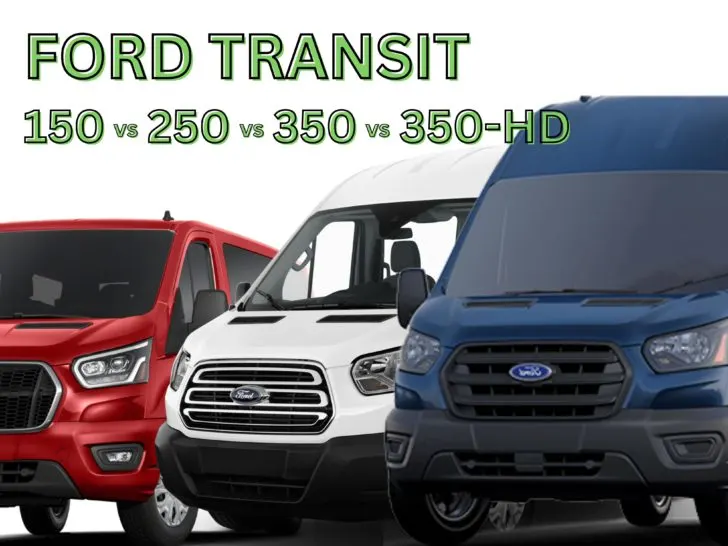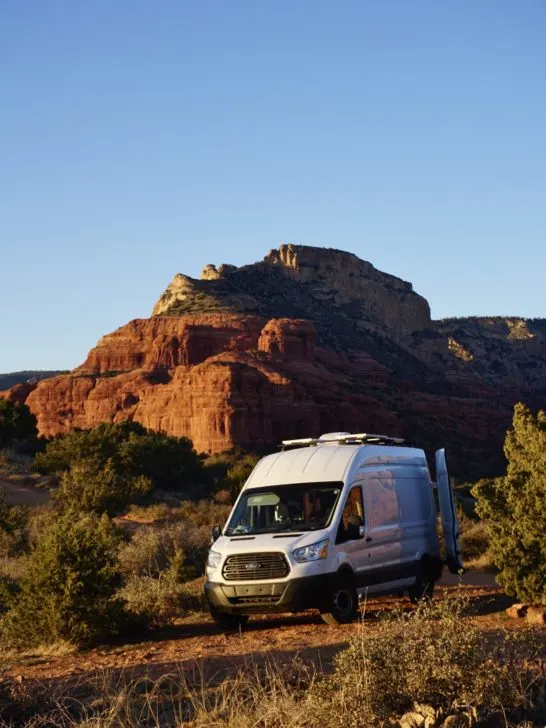What exactly is the difference between Ford Transit 150, 250, 350, and 350-HD? In this post I will explain the difference between these common Ford Transit vans, and why you might choose one over another.

This post is written about the North American version of the Ford Transit. And I referenced mostly specs from the 2023 Ford Transit models. Though, the relationship between Ford Transit 150, 250, 350, 350-HD has remained relatively consistent since its introduction in 2015.
(And if you are curious, other common vans have a similar relationship. So you can roughly apply the same explanation to Mercedes Sprinter and RAM Promaster as well)
The Basic Difference Between Ford Transit Vans
In easy-to-understand terms, the higher the number, the more heavy-duty the van is and the more weight it can haul. A Ford Transit van with a higher number is built with different parts to accommodate more weight (i.e. more robust suspension/brakes/ and other parts).
Terms To Know
Curb Weight – How much a vehicle weighs without passengers or cargo.
GVWR – Gross Vehicle Weight Rating is the maximum weight of a vehicle, including the vehicle itself, plus passengers, cargo, gasoline, and fluids.
Payload – How much weight in cargo and/or passengers a vehicle can carry. You subtract GVWR – Curb Weight = Payload.
What Does The Number On A Ford Transit Signify?
The four tiers of Ford Transit Vans are 150, 250, 350, and 350-HD.
The number in the name of each van indicates tiers of increasing payload (how much weight it can haul).
This is important for helping buyers choose a van that can haul an appropriate amount of weight for their use. From work vans used by businesses and tradesmen, to campervans carrying a conversion and personal belongings.
It’s important for the safety and longevity of your van to ensure that you don’t exceed the maximum payload ratings.
There are two main classifications that help group similar vehicles.
The first is how the US government classifies vehicles (for fuel efficiency). All Ford Transit Vans are classified as Heavy-Duty vehicles because they are over 8500 pounds GVWR and/or 4000 pounds payload capacity.
The second common shorthand way to classify vans is by referring to their payload in terms of tons (one ton = 2000 lbs). Traditionally, the 150 is ½ ton, 250 is a ¾ ton, and 350 is a one ton.
However, this system is wildly outdated because the payload ratings have soared past those definitions. For example, the “one ton” 2023 Ford Transit 350 has a payload rating of around 4,000 lbs, which is literally two tons! And yet, people still use these antiquated terms.
How Is Each Ford Transit Van Built Differently
In most ways, these vans are actually very similar to each other. They really only differ in a few key ways.
In order to haul more weight, each increasing van has certain parts upgraded to accommodate a higher payload. So the Ford Transit 250, 350, and 350-HD are built with more robust suspension, brakes, etc.
Additionally, the 350-HD has the option for dual-rear-wheel (DRW) for an even more stable and robust van configuration.
Ford Transit Van Options
Standard Engine: Gas 3.5L PDFi V6
- Horsepower: 275 HP @ 6,250 RPM
- Torque: 260 lbs-ft @ 4,000 RPM
Optional Engine: Gas 3.5L EcoBoost® V6
- Horsepower: 310 HP @ 5,000 RPM
- Torque: 400 lbs-ft @ 2,500 RPM
Optional Engine: Ford E-Transit All Electric 68-kWh (2022-Present)
- Horsepower: 266 hp
- Torque: 317 lb-ft
Optional Engine: Diesel 3.2L I5 (2015-2019)
- Horsepower: 185 hp @ 3,000 RPM
- Torque: 350 lb-ft @ ~ 1,750 RPM
Drivetrain:
- RWD – Rear Wheel Drive (Standard)
- AWD – All Wheel Drive (Optional – 2020 or later)
Fuel Capacity:
- 25-gallon tank (Standard)
- 31-gallon tank (Optional)
Roof Height:
- Low
- Medium
- High
Wheelbase Options:
- 130″
- 148″
Vehicle Length:
- Regular
- Long
- Long-EL
Wheel Configuration:
- Single Rear Wheel (SRW): 150, 250, 350, 350-HD
- Dual Rear Wheel (DRW): Only 350-HD
Be aware that not all combinations are possible.
For example, a ‘High Roof’ Transit is only available with Transit 250, Transit 350, and Transit 350HD. The ‘High Roof’ option is only available with Long and Long-EL (Extended Length) vans. And there are other examples.
Or conversely, Low and Medium Roof are not available with Long-EL (Extended Length).
Other exclusions exist as well.
Payload Comparison Of Ford Transit Vans
It’s important to choose a van with an appropriate payload rating for your intended use. If you are shopping for a used Ford Transit, generally payloads and towing capacity have steadily increased over time as the technology improves.
For a reasonably equal comparison, we can look at 2023 ‘Medium Roof’ ‘Long Length’ Transits. It’s a good ‘apples to apples’ comparison since this size configuration exists for 150, 250, 350, and 350HD (SRW).
When you control for other variables, we can see the most accurate changes in payload between models.
| Transit Type | GVWR | Payload |
| Transit 150 | 8670 | 3418 |
| Transit 250 | 9070 | 3818 |
| Transit 350 | 9500 | 4248 |
| 350-HD (SRW) | 9950 | 4698 |
Typically, the payload increases by about 400-450 pounds for each increasing tier.
That is, the 350-HD has ≈450 lbs more payload capacity than the Transit 350.
The Transit 350 has ≈430 lbs more payload capacity than the Transit 250.
Transit 250 has ≈400 lbs more payload capacity than the Transit 150.
And besides the Ford Transit’s number, there are other factors that contribute to altering payload ratings. Things like AWD, EcoBoost, vehicle length, etc. all have an impact on the total payload.
The EcoBoost Engine option reduces payload by about 80-100 lbs.
AWD drivetrain option reduces payload by about 100-200 lbs. However, the Ford Transit AWD van is one of the few highly coveted vans with AWD or 4×4.
Larger Ford Transits Have Less Payload
A common misconception is that larger (longer or taller) Ford Transits can carry more payload. And while there is more interior cargo volume for stuff, the larger Transits actually have a lower payload rating compared to a smaller van of the same class.
This is because all Transits classes (150, 250, etc) have the same GVWR. It’s a ‘zero-sum game’. So more vehicle weight (curb weight) just takes a bigger piece of the GVWR pie, and thus subtracts from the payload rating.
This is illustrated in the table below.
| Ford Transit 250 | Regular Length | Long Length | Long-EL |
| Low Roof | 4068 | 3966 | |
| Medium Roof | 3938 | 3818 | |
| High Roof | 3723 | 3520 |
Towing Capacity
The Ford Transit towing rating is the same for 150, 250, 350, 350-HD.
In the past (with Ford E-Series vans) the towing ratings were different for each of the 150, 250, and 350.
However, the Ford Transit’s towing rating varies based on other options (cargo/crew/passenger, standard vs EcoBoost, RWD vs AWD, and wheelbase).
For the 2023 Ford Transit, towing ratings are between 4,200 and 6,900 lbs.
The AWD drivetrain option reduces towing capacity by about 100-300 lbs.
Length & Wheelbase
Ford Transit Vans are available in two different wheelbases and three different body lengths.
The two wheelbases are 130” and 148”. And the three lengths are regular, long, and extended length (long-EL).
The 148” wheelbase comes on the long and long-EL Transits.
And the 130” wheelbase comes on the regular-length Ford Transit.
Ford Transit Roof Heights
The Ford Transit is available in three different roof heights: low, medium, and high.
The High and Medium roof options make Ford Transit one of the best vans that offer standing room inside.
Cargo Vs. Passenger (Wagon)
Ford Transits are offered in cargo, passenger, or crew models.
Cargo vans have just the driver seat and passenger up front and the back is just an empty metal shell. There are usually only windows in the cab and on the back doors.
The Transit passenger models (aka wagon) are meant for carrying passengers (up to 15 people). They have seats, windows on all sides, a finished interior, and rear climate control, lights, charge ports, speakers, etc.
The Transit crew models are basically a hybrid of the two. They typically have just a second row of seats and some windows and comforts for rear-seated passengers. But otherwise, the back of the van is empty for cargo.
What Does XL and XLT Stand For?
I despise that Ford insists on using XL and XLT to describe different trim options. Obviously, it’s confusing that these common acronyms (i.e. XL = extra large) don’t have anything to do with the length or size of the van.
These XL and XLT trims include extra features that make the van more comfortable for passengers. Thus they are typically only found on the passenger (wagon) models. Basically, think of it like all the extra bells and whistles that aren’t standard on a base model.
It can include rear air-conditioning, satellite radio, nicer upholstery, and more.
What It’s Like Owning A Ford Transit

That’s pretty much the end of the easily quantifiable differences between Ford Transit 150, 250, 350, and 350-HD. But smart buyers will still wonder how these different models compare in categories with larger variance, such as Fuel Economy, Cost of Ownership, and Longevity.
I’ve spent hours researching the more nuanced differences between Ford Transit vans. The problem is that finding concrete evidence to support claims is difficult because the real world doesn’t function like some perfectly controlled science experiment.
And getting concrete answers is difficult because:
- The manufacturers’ and dealers’ claims are sometimes not consistent with the real-world numbers.
- Or you can turn to automotive websites {like Edmunds.com, Autoblog.com, etc} who either regurgitate the manufacturers’ claims or try (and possibly fail) to make predictions about real-world MPG, Cost of Ownership, etc.
- And lastly, you have just regular people on forums and blogs providing their own anecdotal “evidence” to support their claims. And obviously, that method is subject to bias.
So I’ve done my best to summarize the things that are generally accepted as true. That is, multiple sources confirm roughly the same information.
But one huge piece of advice that I hear echoed over and over from fleet owners and mechanics is this:
How you treat your van is much more important than which one you have. Any marginal difference in fuel economy, repair costs, and longevity can be obliterated by poor ownership.
Fuel Economy
The fuel economy generally gets worse with each increasing model. But the difference between Ford Transit T-150, T-250, and T-350 is only a few MPG.
And this of course depends on how you use the van. Because an overloaded Transit 150 may get worse MPG than a Transit 350 working comfortably within its GVWR.
Ride Comfort
The fact that these vans are tuned for specific payloads, means that they ride smoother when loaded properly.
So an empty Transit 350 is going to be a really rough ride. Conversely, an overloaded T-150 will also be rough, because the suspension is bottoming out. If you drive the van empty occasionally, then the Transit 150 and 250 are better tuned for alternating between loaded and unloaded.
Repairs and Maintenance
The repairs and maintenance will on average cost more for each increasing model.
And the Ford Transit 350-HD with dual-rear-wheels will increase the overall cost of the vehicle and parts/maintenance. It’s really only necessary for very high payloads or heavy towing.
But duallys have the benefit of more lateral stability, which will benefit tall vans that often get pushed around by strong winds.
Longevity
Since the Ford Transit is still a somewhat newer vehicle (since 2015) the verdict isn’t in on their longevity.
A WELL-MAINTAINED Ford Transit van should last up to 200k miles without major issues. And with good luck, they can reach up to 300k miles or above.
As far as the difference between Ford Transit 150, 250, and 350 vans, I’ve only seen anecdotal claims that the 250s and 350s vans last longer. But it’s hard to find concrete evidence of this in the real world. It may be that Transit 150 owners are just overloading their vans, so they don’t last as long.
What’s The Difference Between Ford Transit and Ford Econoline?
The Ford Econoline or E-Series is the former line of full-size Ford Vans. The Econoline or E-Series vans were in production from 1961-2014.
However, from 2015 to the Present you can still purchase the stripped chassis or cutaway chassis models.
Conclusion: Which Ford Transit Van Is Best?

The primary factor when choosing from the Transit lineup is payload, since that is the main quantifiable difference between Ford Transit 150, 250, 350, and 350-HD.
Simply put, you need a van capable of handling the weight you need to move. But equally important is finding a van that’s in good mechanical shape.
In the context of campervan conversions, the weight of your conversion materials will dictate the payload required. This will depend on what type of conversion you’re planning.
A general rule of thumb is that Transit 250 and Transit 350 are best for elaborate conversions for 2 or more people with wooden furniture, water tanks, batteries, and all your belongings.
The Transit 150 is better suited for builds with lightweight materials (plastic, foam, aluminum) or “weekend-warrior” type conversions that aren’t loaded with so many personal belongings.
The Transit 350-HD, and especially the dually version, can handle the highest payloads. Though generally, I think it’s overkill for most campervans. And duallys are also worse for maneuverability and off-road driving.
Ford recently introduced the Ford Transit Trail as a van specifically optimized for vanlife. Here’s my Ford Transit Trail review on if it’s worth it.
Resources:
